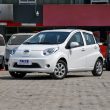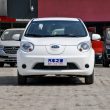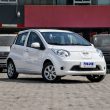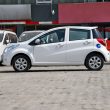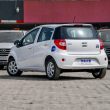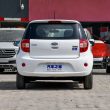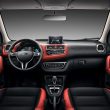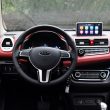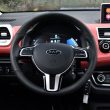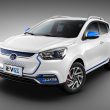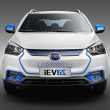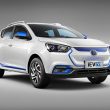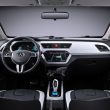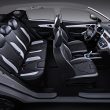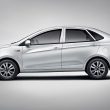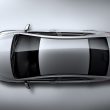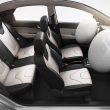What to expect from JAC electric cars in Pakistan!
Electric vehicles and information about new entrants have been the prime focus of the Pakistani automotive news for quite some time now. The incentives given in the budget for fiscal year 2018-2019 and the critically acclaimed Auto Policy 2016-2021 have made local production of electric vehicles a feasible and appealing proposition for new entrants. Today we will be talking about one such instance, the Chinese automaker JAC Motors. Earlier this year Deputy Chief Economic Manager of the company, David Zhang stated that they are planning to introduce electric cars in Pakistan under a long-term development program. But before they reveal any further details, lets take a look at some of the electric cars which the automakers sells outside the shores of our country to see what’s in store for us.
Also Read: JAC to introduce electric vehicles in Pakistan
But first lets take a moment to talk about JAC motors in general. Staring life in 1964 as “Hefei Jianghuai Automobile Factory”, the Chinese automaker almost exclusively made commercial vehicles, trucks, vans and busses. In 1997, the company’s name was changed to “Anhui Jianghuai Automobile Co.” or JAC for short. In the early 2000s, the company started manufacturing passenger cars, MPVs and SUVs and had joint ventures with Hyundai, Navistar International (A diesel engine manufacturer), NC2 Global and the Mexican carmaker, Giant Motors. Shortly. JAC’s shift from commercial vehicles towards passenger cars was further demonstrated by its 2010 electric vehicle development programme, as a result of which we may see JAC EVs on Pakistani roads. JAC operates internationally by exporting CKD (Completely Knocked Down) units in many countries including including Egypt, Ethiopia, Iran, Mexico and Vietnam and quite possibility Pakistan in coming times.
I believe that’s enough preamble for today, so without further ado lets take a look at the JAC EVs that we might see on Pakistani roads in the near future.
JAC iEV-6E:
- Range: 156 km
- Power: 61 HP
- Torque: 175 Nm
- Efficiency: 0.13 kWh/km
- Price (Estimate) : PKR 1 850 000
Starting our list is the compact electric hatch, iEV-6E. It shares its platform and body parts with with the JAC YueYue and is about the same size as the new Suzuki Cultus, the expected Kia Picanto and Hyundai i10. The iEV-6E’s powertrain consists of a 20 kWh battery powering a 45 kW electric motor generating 61 HP and 175 Nm of torque, which is more than adequate for a car that weighs just 890 kg. This electric motors drives the front wheels via a one-speed reduction gear, which means that there are no gears to shift at all! Like most Chinese cars the suspension is tuned to be comfortable and does a good job of dealing with bumps and potholes. The instant 175 Nm of torque makes city driving a breeze due to the sprightly acceleration. The interior features a sporty two tone design that is better than any other vehicle in this class, JAC’s build quality has been commendable lately but no conclusions can be made about build quality until we get our hands on one. Amenities include steering wheel mounted controls, cruise control, a 7-inch LCD infotainment screen, digital climate control and 14-inch alloy wheels. Safety features like ABS, traction control system, crumple zones and SRS front and side curtain airbags are also present. The NEDC rated range of 156 km make it optimal for city use, although longer highway cruises may present a challenge. While some of you may have cringed at the 18 Lac-ish estimated price, note that EVs often cost a lot more than their conventionally motivated rivals and gradually make up for their higher price with lower running costs. Consider the calculation below:
Fuel Cost Per Year: Suzuki Cultus AGS
Fuel Economy (As Stated in PakWheels Review): 18 km/l
Price of Petrol as of 14th June 2018: ~ PKR 91.96/liter
Cost of Driving (20 000 Km) Yearly:
= PKR (91.96/18) * 20 000
= PKR 102 000
Fuel Cost Per Year: JAC iEV-6E
Rated Efficiency: 0.13 kWh/km
- 1-100 units = Rs. 5.79 per unit
- 101-200 units = Rs. 8.11 per unit
- 201-300 units = Rs. 10.20 per unit
- 301-700 units = Rs. 16.00 per unit
- Above 700 units = Rs. 18.00 per unit
Driving 20 000 km per Year = Driving 1667 Km per Month
Total Units:
= 0.13*1667
= 217 Units/Month
Cost Per Month:
= PKR 100*5.79 + 100*8.11 + 17*10.20
= PKR 1563
Cost of Driving (20 000 km) Yearly:
= PKR 1563*12
= PKR 18 760
Through this calculation it is made clear that an EV (like the JAC iEV-6E being discussed here) costs much less (PKR 83 240 less to be exact) to run than a similar car with an internal combustion engine. That means that even if the JAC iEV-6E costs 2 lacs more than the equivalent Cultus, it will take just 2.5 years to compensate for the price difference with lower running costs and this is without taking into account the multiple oil changes, turnings and other maintenance that an internal combustion engine requires.
JAC iEV-6S:
- Range: 251 km
- Power: 115 HP
- Torque: 270 Nm
- Efficiency: 0.12 kWh/km
- Price (Estimate) : PKR 3 300 000 – 3 500 000
Electric crossovers seem to be the trend these, from Hyundai’s Kona EV to Audi‘s e-Tron Quattro to this, electric crossovers look more “avant-garde” than sedans or hatchbacks and this appeal is always beneficial to new technology. JAC’s entry into this segment is the iEV-6S and is about the same size as a compact crossover like a Honda Vezel or Toyota C-HR. The front end is reminiscent of Hyundai models and the car is designed to be aerodynamic rather than quirky looking. It features LED headlamps, DRLs and fog lamps upfront while the blue accents hint at its eco-friendly powertrain. A 33 kWh battery gives a range of 251 km while the 85 kW electric motors puts out 115 HP and 270 Nm of torque, a one-speed gear negates the need for a complex transmission. The big torque figure makes it very pleasant to drive in day to day situations as it makes the car very responsive to inputs. The interior feels like an upmarket version of the iEV-6E and carries over the same two-tone design language and build quality. Cabin tech includes cruise control, steering wheel controls, digital climate control, an 8-inch LCD infotainment screen and a 4.2 inch LCD helper screen in the instrument panel that displays vehicle statistics like trip information, efficiency or the odometer. Safety features include ABS, traction control, EBD, front crumple zone, dual front airbags, side curtain airbags and driver and passenger side airbags though adaptive cruise control, auto emergency braking and lane departure prevention are a major omission at this price point. The suspension features McPherson struts upfront and a torsion beam in the rear and is tuned for comfort rather than fun, so it deals with bumps and imperfections on the road well. A range of 251 km makes it more practical and livable than its little sibling, the iEV-6E. Because it is an EV, the iEV-6S costs a lot less to run than its conventionally motivated rivals, it costs around PKR 90 000 an year less to run than a Honda Vezel Hybrid, which is a pretty efficient car itself (Assuming a Honda Vezel does 17 km/l, using K-Electric Billing Slabs and Petrol priced at 91.96 PKR/Liter) and that is excluding any maintenance.
JAC iEV-7:
- Range: 180 km
- Power: 68 HP
- Torque: 215 Nm
- Efficiency: 0.13 kWh/km
- Price (Estimate) : PKR 2 500 000 – 2 750 000
Unlike the rest of the world, sedans are still popular in China and JAC’s EV lineup would be incomplete without one, the iEV-7 is compact sedan and competes in the same segment as the Toyota Corolla, Honda Civic and the upcoming Hyundai Elantra. The iEV-7 lags behind its competitors in the style department and doesn’t make as bold of a statement as its crossover siblings or even other sedans in this segment. The 24 kWh battery combined with the 50 kW electric motor is good for 180 km of range, 68 HP and 215 Nm of torque. The baroque two tone interior is built well and appeals to a much older audience than the company’s usual offerings. The cabin tech is the usual affair with cruise control, steering wheel controls, a 4.2 inch LCD helper display and a 7-inch infotainment LCD while safety tech includes 6 airbags, ABS, traction control EBD and front and rear crumple zones. While the 68 HP figure may seem uninteresting and dreary on paper, but in reality it is more than good enough due to the instant 215 Nm of torque. A range of 180 km may be short by 2018 standards but still plenty for city driving, though longer highway commutes continues to be the Achilles’ heel of short range EVs like these. Like all EVs, running costs are a fraction of other cars in this class and the iE-7 may save upto 100 000 PKR annually (Driving 20000 km, using K-Electric Billing Slabs and Petrol priced at 91.96 PKR/Liter) versus more traditionally powered rivals like the Toyota Corolla or the Honda Civic. Overall, the iEV-7 is a solid vehicle but with limited appeal, the short range, high price and lack of audacious styling and modern features hold this car back in my opinion as most people would be hard pressed to pay 27 lac PKR for car that looks as drab and on paper only puts out as much as power as Corolla GLi.
Final thoughts
So these were my two cents on what to expect from JAC EVs and in all honesty, I am a bit underwhelmed. JAC has been very successful selling EVs in China but that is largely due to the massive subsidies and incentives that the government provides. For instance due to the aforementioned incentives the iEV-6S costs just 119 500 CNY (22.5 Lacs PKR) in China. Moreover, the charging infrastructure in Pakistan is still in its infancy (major developments have thus far only been done by Dewan Motors) and if JAC EVs are here to stay the company needs to invest in charging stations and creating an “EV presence” on Pakistani roads.
That’s all for today, as usual feel free to leave your thoughts in the comments below and stay tuned to PakWheels.com to stay on top of the electric car scene in Pakistan.


